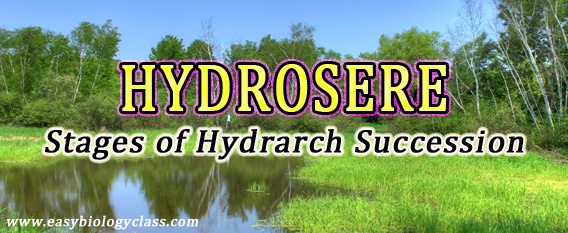What is Hydrosere or Hydrarch Succession?
A succession originates in a water body (aquatic environment) is called Hydrosere or Hydrarch Succession. Such a succession does not necessarily lead to the development of a land community. If the water body is sufficiently large and with wave action, the succession usually results in the formation of a large aquatic climax community.
If the hydrarch succession starts from a comparatively small water body such as a pond, there is always a high probability for the formation of a terrestrial climax community. The important characteristics of hydrosere are given below:
Learn more: Process of Ecological Succession
Learn more: Types of Ecological Succession
Ø Hydrosere usually starts from a pond
Ø Phytoplanktons will be the pioneer community
Ø A forest or a grassland will be the climax community
Ø Includes several seral stages of plant and animal communities
| You may also like NOTES in... | ||
|---|---|---|
| BOTANY | BIOCHEMISTRY | MOL. BIOLOGY |
| ZOOLOGY | MICROBIOLOGY | BIOSTATISTICS |
| ECOLOGY | IMMUNOLOGY | BIOTECHNOLOGY |
| GENETICS | EMBRYOLOGY | PHYSIOLOGY |
| EVOLUTION | BIOPHYSICS | BIOINFORMATICS |
Ø Seral communities of plants are more obvious than animals.
Just like other successions, the hydrosere is also completed through a sequence of several Seral Stages (Seral Communities). The seral stages of a typical Hydrosere succession are as follows:
Seral stages of Hydrosere
(1). Phyto-planktons stage
(2). Rooted submerged stage
(3). Rooted floating stage
(4). Reed-swamp stage
(5). Sedge-meadow stage
(6). Woodland stage
(7). Forest stage
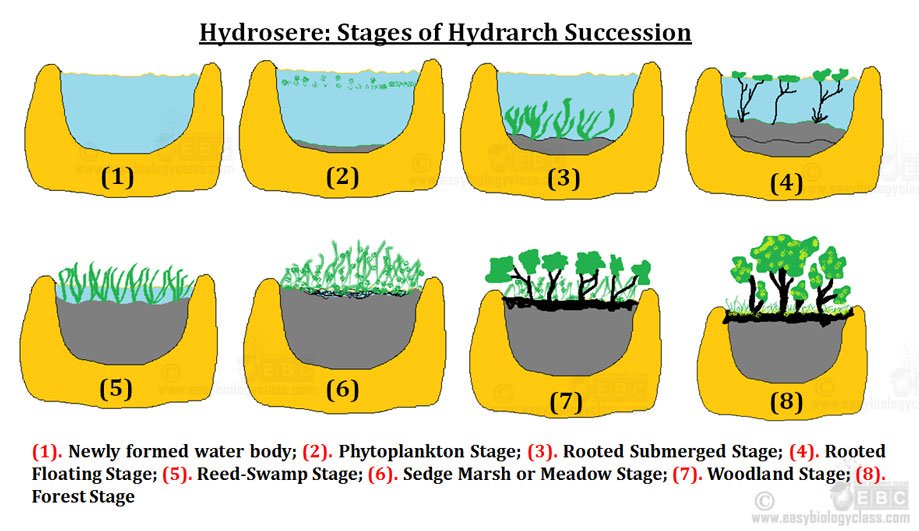
(1). Phytoplankton stage:
Ø Phytoplanktons will be pioneer community in the hydrosere.
Ø Algal spores are brought into the water in the initial stages of the succession.
Ø These algal spores germinate and quickly colonize in the water body.
Ø They multiply and grow for some time. They fix light energy (photosynthesis).
Ø Blue green algae, green algae, diatoms, bacteria etc. the plankton communities.
Ø Large number of minute free floating zoo-planktons will also appear.
Ø Various growth activities of these planktons and their death add nutrients to soil and water.
Ø After their death, they settle down at the bottom of the pond to form a layer of muck.
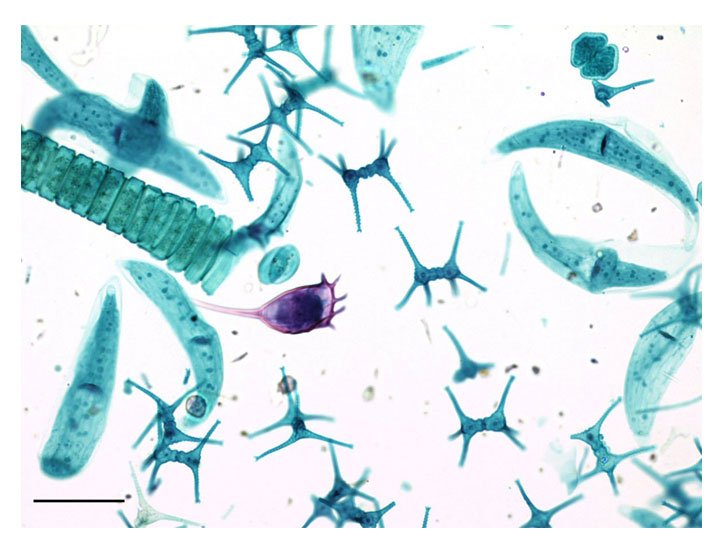
image source: cc – wikipedia
(2). Rooted submerged stage:
Ø Nutrients are added to the soil and water by the death and decomposition of planktons.
Ø Subsequently a soft muddy bottom with rich silt forms.
Ø Due to the formation of muddy bottom, the water depth becomes shallower.
Ø Once the water depth is reduced to about 10 feet, the complete light penetration becomes easy.
Ø This promotes the growth of rooted submerged hydrophytes.
Ø These plants will be completely submerged in the water.
Ø Example: Hydrilla, Vallisneria, Utricullaria, Chara, Ceratophyllum
Ø The nutrient rich muddy bottom helps to quickly flourish their population.
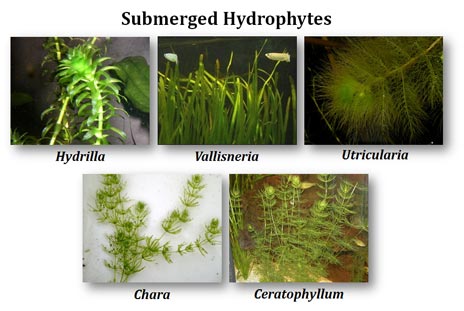
image source: cc – wikipedia
(3). Rooted floating stage:
Ø When the depth of water reaches about 4 to 8 feet, the submerged vegetation starts disappearing from their original place.
Ø Death and decomposition of these rooted plants add more nutrients to the soil.
Ø This further increase the width of bottom soil or silt.
Ø In this condition, rooted floating hydrophytes starts to appear.
Ø These rooted floating plants quickly cover the water surface and their floating leaves completely cover the water body.
Ø As a result of this, the light penetration into the water is inhibited and this results in the complete disappearance of submerged plants.
Ø Examples of rooted floating plants: Nelumbium, Nymphaea, Trapa

image source: cc – wikipedia
Ø Free floating plants can also develop: Azolla, Lemna, Wolffia, Pistia, Salvinia
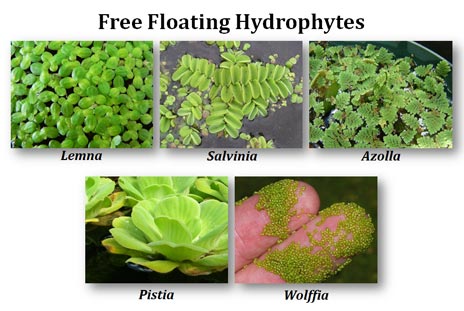
image source: cc – wikipedia
(4). Reed-swamp stage:
Ø The Reed-swamp stage is also called the Amphibious Stage.
Ø The water level very much reduced (reduced to 1 to 3 feet).
Ø The level of soil and silt increases and in this condition, the rooted floating plants cannot survive there.
Ø The soil becomes more fertile by death and decay of plants.
Ø In this stage, the rooted floating plants are replaced by plant communities which can survive both in water and terrestrial conditions (hence the name amphibious stage) will develop.
Ø Most of these plants will be rooted, but their shoots are exposed to the air. They have well-developed rhizome.
Ø Plants in this stage form very dense vegetation over the area and this will prevent the light penetration to the lower portion.
Ø At this condition, the remaining rooted floating or free floating or submerged plants of the previous seral stage disappears.
Ø Example: Typha, Sagittaria, Polygonum

image source: cc – wikipedia
(5). Sedge Marsh or Meadow Stage:
Ø Water level further decreases and the filling process results in the formation of a marshy soil.
Ø The marshy soil is unsuitable for the pre-existing community (reed-swamp community).
Ø Plants of Cyperaceae and Poaceae start to develop and they predominate in the area.
Ø The rhizomes of these plants are well developed and they are interconnected to each other.
Ø They form mat-like vegetation over the top of the soil.
Ø The luxurious growth of these plants will modify the current soil.
Ø These plants have a high rate of transpiration and they remove a large amount of water from the soil results in further reduction of moisture.
Ø Due to loss of water by transpiration, the soil becomes exposed to air for the first time.
Ø Once the soil is exposed to the air, the nutrients such as ammonia and sulfides become oxidized to nitrates & sulfates. Oxidation also results in the breakdown of other complex organic components in the soil to simple compounds.
Ø All these ultimately results in the formation of Terrestrial Soil.

image source: cc – wikipedia
(6). Woodland stage:
Ø In this stage, some shrubs and medium sized trees will starts to appear.
Ø These plants will prevent the light penetration to the bottom region and hence the marshy vegetation in the body gradually shrinks.
Ø The soil will stay dry in most of the time.
Ø Shrubs and herbs gradually predominates the area.
Ø Shedding of leaves from the shrubs and trees results in the huge accumulation of humus in the soil.
Ø A variety of decomposers of bacterial and fungal groups in the soil quickly break-down these organic matter results in a further increase of fertility of the top soil.
Ø Example of plants: Salix, Eupatorium, Alnus,Acacia, Cassia, Terminalia
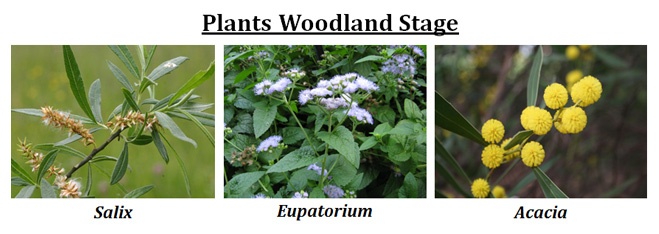
image source: cc – wikipedia
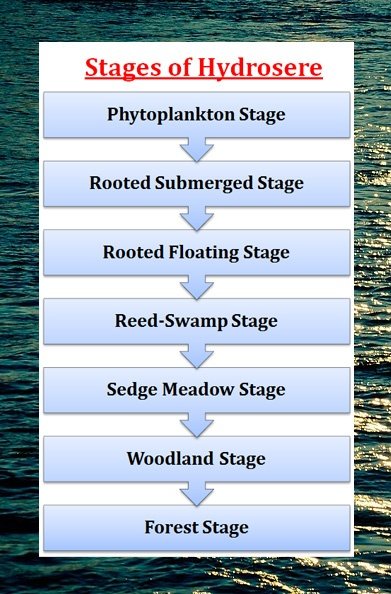
(7). Forest stage:
Ø Forest stage is the climax community in hydrarch succession.
Ø The woodland community is invaded by large tree forms.
Ø Tree forms gradually predominate the area and their canopy covers the entire area.
Ø The light penetration to the lower canopy becomes reduced and this results in the reduction of herb and shrub population.
| You may also like... | ||
|---|---|---|
| NOTES | QUESTION BANK | COMPETITIVE EXAMS. |
| PPTs | UNIVERSITY EXAMS | DIFFERENCE BETWEEN.. |
| MCQs | PLUS ONE BIOLOGY | NEWS & JOBS |
| MOCK TESTS | PLUS TWO BIOLOGY | PRACTICAL |
Ø This condition also promoted the occurrence of large wooded climbers. These climbers (lianas) will climb over the trees for sunlight.
Ø The climate of the region determines the type of forest (evergreen, deciduous etc.)
Ø Example of plants: Shorea, Quercus, Acer
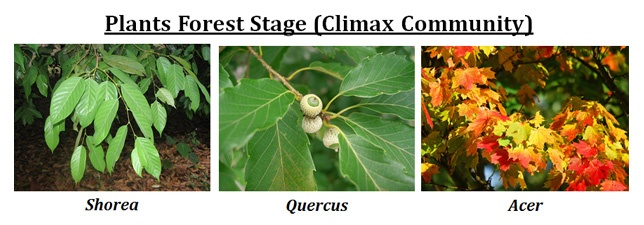
image source: cc – wikipedia
The climax forest community is stable and self-sustainable. All types of communities such as herbs, shrubs, trees, climbers, animals, decomposers etc. are present in the climax community in correct proportion. At the climax stage, a complete harmony is developed between the plant communities with the habitat. The process of hydrosere is a gradual process and it may take thousands of years to complete.
